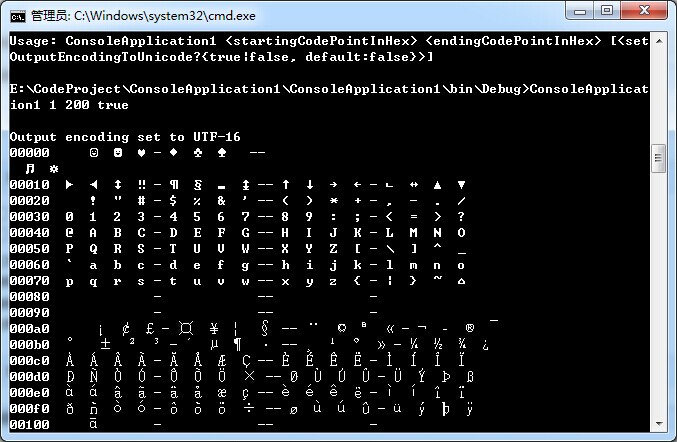从 .NET Framework 4.5 开始,Console 类支持与 UnicodeEncoding 类的 UTF-16 编码。 显示 Unicode 字符到控制台,你可以设置 OutputEncoding 属性为 UTF8Encoding 或 UnicodeEncoding。
下面的示例显示 Unicode 字符的范围到控制台中。 该示例接受三个命令行参数:显示范围的开头,显示范围的末尾,以及是否使用当前控制台编码 (false) 或 UTF-16 编码 (true)。 假定控制台使用一个 TrueType 字体。
class Program { private static void Main(string[] args) { uint rangeStart = 0; uint rangeEnd = 0; bool setOutputEncodingToUnicode = true; // Get the current encoding so we can restore it. Encoding originalOutputEncoding = Console.OutputEncoding; try { switch (args.Length) { case 2: rangeStart = uint.Parse(args[0], NumberStyles.HexNumber); rangeEnd = uint.Parse(args[1], NumberStyles.HexNumber); setOutputEncodingToUnicode = true; break; case 3: if (!uint.TryParse(args[0], NumberStyles.HexNumber, null, out rangeStart)) throw new ArgumentException(String.Format("{0} is not a valid hexadecimal number.", args[0])); if (!uint.TryParse(args[1], NumberStyles.HexNumber, null, out rangeEnd)) throw new ArgumentException(String.Format("{0} is not a valid hexadecimal number.", args[1])); bool.TryParse(args[2], out setOutputEncodingToUnicode); break; default: Console.WriteLine("Usage: {0} <{1}> <{2}> [{3}]", Environment.GetCommandLineArgs()[0], "startingCodePointInHex", "endingCodePointInHex", "<setOutputEncodingToUnicode?{true|false, default:false}>"); return; } if (setOutputEncodingToUnicode) { // This won't work before .NET Framework 4.5. try { // Set encoding using endianness of this system. // We're interested in displaying individual Char objects, so // we don't want a Unicode BOM or exceptions to be thrown on // invalid Char values. Console.OutputEncoding = new UnicodeEncoding(!BitConverter.IsLittleEndian, false); Console.WriteLine(" Output encoding set to UTF-16"); } catch (IOException) { Console.OutputEncoding = new UTF8Encoding(); Console.WriteLine("Output encoding set to UTF-8"); } } else { Console.WriteLine("The console encoding is {0} (code page {1})", Console.OutputEncoding.EncodingName, Console.OutputEncoding.CodePage); } DisplayRange(rangeStart, rangeEnd); } catch (ArgumentException ex) { Console.WriteLine(ex.Message); } finally { // Restore console environment. Console.OutputEncoding = originalOutputEncoding; } } public static void DisplayRange(uint start, uint end) { const uint upperRange = 0x10FFFF; const uint surrogateStart = 0xD800; const uint surrogateEnd = 0xDFFF; if (end <= start) { uint t = start; start = end; end = t; } // Check whether the start or end range is outside of last plane. if (start > upperRange) throw new ArgumentException(String.Format("0x{0:X5} is outside the upper range of Unicode code points (0x{1:X5})", start, upperRange)); if (end > upperRange) throw new ArgumentException(String.Format("0x{0:X5} is outside the upper range of Unicode code points (0x{0:X5})", end, upperRange)); // Since we're using 21-bit code points, we can't use U+D800 to U+DFFF. if ((start < surrogateStart & end > surrogateStart) || (start >= surrogateStart & start <= surrogateEnd)) throw new ArgumentException(String.Format("0x{0:X5}-0x{1:X5} includes the surrogate pair range 0x{2:X5}-0x{3:X5}", start, end, surrogateStart, surrogateEnd)); uint last = RoundUpToMultipleOf(0x10, end); uint first = RoundDownToMultipleOf(0x10, start); uint rows = (last - first) / 0x10; for (uint r = 0; r < rows; ++r) { // Display the row header. Console.Write("{0:x5} ", first + 0x10 * r); for (uint c = 0; c < 0x10; ++c) { uint cur = (first + 0x10 * r + c); if (cur < start) { Console.Write(" {0} ", Convert.ToChar(0x20)); } else if (end < cur) { Console.Write(" {0} ", Convert.ToChar(0x20)); } else { // the cast to int is safe, since we know that val <= upperRange. String chars = Char.ConvertFromUtf32((int)cur); // Display a space for code points that are not valid characters. if (CharUnicodeInfo.GetUnicodeCategory(chars[0]) == UnicodeCategory.OtherNotAssigned) Console.Write(" {0} ", Convert.ToChar(0x20)); // Display a space for code points in the private use area. else if (CharUnicodeInfo.GetUnicodeCategory(chars[0]) == UnicodeCategory.PrivateUse) Console.Write(" {0} ", Convert.ToChar(0x20)); // Is surrogate pair a valid character? // Note that the console will interpret the high and low surrogate // as separate (and unrecognizable) characters. else if (chars.Length > 1 && CharUnicodeInfo.GetUnicodeCategory(chars, 0) == UnicodeCategory.OtherNotAssigned) Console.Write(" {0} ", Convert.ToChar(0x20)); else Console.Write(" {0} ", chars); } switch (c) { case 3: case 11: Console.Write("-"); break; case 7: Console.Write("--"); break; } } Console.WriteLine(); if (0 < r && r % 0x10 == 0) Console.WriteLine(); } } private static uint RoundUpToMultipleOf(uint b, uint u) { return RoundDownToMultipleOf(b, u) + b; } private static uint RoundDownToMultipleOf(uint b, uint u) { return u - (u % b); } }
演示结果
